Gyakugatte Dairo
In Kyōto, around the middle of February, the weather temperature is getting pleasantly warm, so that additional heat from the Dairo may not be the reason Gen-gen-sai Sei-chū Sō-shitsu, 玄々斎精中 宗室, (1810 – 1877) developed the dai-ro, 大炉, great-hearth. On February 19 is U-sui, 雨水, Rain-water, one of the 24 seasonal divisions of the solar calendar, and the middle of the Tora no Tsuki, 寅の月, Tiger ’s Month. In Japan, the Gregorian calendar officially began to be used in 1873. In 2023, the lunar 2 month begins February 20. Lunar Nehane occurs on March 6.
Dairo may have a word play on Miyako-ō-ji, 都大路, Capital-great-way, the avenue in the capital; busy main street of the capital; main thoroughfare. Ō-ji, 大路, great-path, may refer to the great way of Nehan. Dairo can refer to the the great way of Nehan, Buddha’s Nirvana.
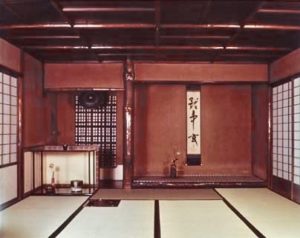
The width of the toko-no-ma, 床の間, floor’s-room, in Totsu-totsu-sai,咄々斎, Tsk-tsk-abstain, is one and a quarter tatami. An important feature of the location of the toko-bashira, 床柱, floor-post, is that, were the tatami on the left and near sides of the room removed, the result would create an ideal yo-jō-han, 四畳半, four-tatami-half, Tearoom, with the tokobashira in the middle of the wall. The ro, 炉, hearth, is located in the adjacent tatami.
In the realm of Chanoyu, there are in the cha-shitsu, 茶室, tea-room, eight different locations of the ro, 炉, hearth, called hachi-ro, 八炉, eight-hearth. Eight is the number of Infinity in Space. Ostensibly, there are just four locations of the ro, called hon-ga-tte, 本勝手, true-prevail-hand, with an additional four that are mirror images of the others. They are called gyaku-ga-tte, 逆勝手, opposite-prevail-hand. The word, ka-tte, 勝手, refers to the adjoining preparation room, such as the mizu-ya, 水屋, water-house.
Established Tearoom complexes often have adjoining rooms that are separated by fusuma, 襖, opaque papered sliding wall panels. A typical two-room arrangement is composed of a hachi-jō, 八畳, eight-tatami, with adjoining roku-jō, 六畳, six-tatami. The fusuma are removeable, so that the rooms combine create a large 14- mat Tearoom. The principal rooms of Urasenke’s Konnichian are Totsutotsusai which is a hachijō, and a rokujō tsugi-no-ma, 次の間, next-’s-room.
Urasenke is a place where many people come to study and practice Chanoyu, so that most available rooms are used for teaching and presenting Tea. This includes the tsuginoma. During the cold season, a ro is opened in each of the rooms. There are areas where a ro is opened only on very special occasions.
Gen-gen-sai, 玄々斎, Mystery-mystery-abstain, XI Iemoto of Urasenke enlarged his Kon-nichi-an, 今日庵, Now-day-hut, home for the 250th anniversary of Rikyū’s death, he created the Totsutotsusai, and its tsuginoma. When he designed the tsuginoma he built a standard ro in the usual hon-gatte style, but also created a dai-ro, 大炉, great-hearth, to be opened and used in the second month of the year when Kyōto is at its coldest.
The Buddhist guardian of the second lunar month is Mon-ju Bo-satsu, 文殊菩薩, Literary-exceptional Grass-buddha, who is guardian of the east, and together with Fu-gen Bo-satsu, 普賢菩薩, Universal-wisdom Grass-buddha, accompanies the historical Buddha. Monju is the guardian of the zodiac sign of the U, 卯, Hare, which is the sign of the year 2023.
The kama used with the dairo is like other ro-gama, 炉釜, hearth-kettles, although, some of the large kama have very large lids. The remainder of the large opening of the ro-dan, 炉壇, heart-foundation, is left open to allow heat from the charcoal fire to provide additional heat to the room.
The opening in the floor for a standard ro-buchi, 炉縁, hearth-frame, is 14 sun kane-jaku, 16 3/4 inches. The opening for the dai-ro, 大炉, great-hearth, is 14 sun kujira-jaku, 21 inches.
The futaoki is placed 5 tatami me, 目, eye, from the heri, 縁, edge, of the adjacent tatami, aligned with ro-buchi.
The origin of the gyaku-gatte style has its foundations in the location of the portable brazier, fu-ro, 風炉, wind-hearth, in the era before Rikyū. There were places and people who continued that arrangement of utensils using the ro, which was being created in part by Rikyū. This arrangement was regarded as, but not necessarily called, ‘hon-gatte’. This style was the manner in which Tea was presented in Buddhist temples, using the formal dai-su, 台子, support-of. manner. The furo was used, and it was displayed on the right side of the daisu, with a mizu-sashi, 水指, water-indicate, on the left side of the daisu. The ro, the hearth sunk in the floor, was based on the i-ro-ri, 囲炉裏, enclose-hearth-inner, the hearth on the level of the floor had been the center of the home for cooking and heating for generations. The ro for Chanoyu was established in the time of Rikyū, and was located in the floor of the tearoom in the adjoining tatami. The hearth was called a de-ro, 出炉, outer-hearth, as there was no place for such a construction as part of the daisu. The relationship between the daisu on the ro to the left, at present is called gyaku-ga-tte, 逆勝手, reverse-prevail-hand.
It is my belief that with the creation of the ro, the usual handling of utensils was awkward with the position of the dero. Personal experience has been the source of this belief, when handling the hi-shaku, 柄杓, handle-ladle, to ladle water from the kama, and resting the hishaku on the kama. When scooping tea out of a cha-ki, 茶器, tea-container, the bottom of the container faces the guest, and common Japanese etiquette frowns on this behavior.
Perhaps the change in displaying the furo on the left, as in the opposite arrangement, had been influenced by the nature of the Eki-kyō, 易経, Change-sutra, Chinese I Ching, and its ha-kke, 八卦, eight-divination signs. The Ekikyō had influences all aspects of Chinese culture, which were continued when the divination system was adopted by Japan. There was little conflict between the Ekikyō and Buddhism, as long as Buddhism was advocated by the government.
When a person walks into a Tearoom, he or she steps in with the right foot, and leaves with the left foot. This is the custom of Urasenke. At neighboring Omotesenke, one enters the Tearoom with the left foot, and leaves with the right foot. According to general Japanese tradition, a sacred place is entered with the left foot, and is exited with the right foot. It might be understood that Omotesenke is a sacred place.
Omotesenke and Urasenke occupy the same property in Kyōto, with Urasenke located to the north of Omotesenke. Once, Omotesenke was called Shimo-Sen-ke, 下千家, Down-Thousand-family, and Urasenke was called Kami-Sen-ke, 上千家, Up-thousand-family, but the names were changed because of feelings of ‘superior’ and ‘inferior’. A fence separates Omotesenke and Urasenke. When one leaves Omotesenke with the right foot, one enters Urasenke with the customarily correct right foot, and likewise leaves Urasenke with the left foot, and enters Omotesenke with the correct left foot.
When entering the gyaku-gatte tsuginoma of Totsutotsusai, one steps into the room with the left foot, and leaves with the right foot. Entering with the left foot is like entering a sacred place, which reinforces the Buddhist aspect of the gyaku-gatte tenmae.
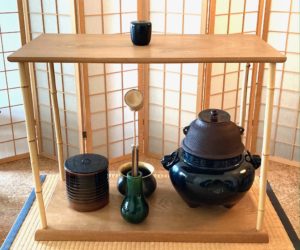
The hi-bashi, 火箸, fire-rods, are in the direction of deity, and the teishu mirroring deity, first handles the hibashi to begin a presentation. The Kanji, 主, in the word tei-shu, 亭主, house-master, means master of fire.
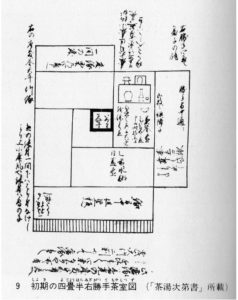
Gyaku-gatte has its origins in old Buddhist Tea presentations, that were prevalent in the domestic life of Tea people. In the time of Gengensai, the six-mat room adjoining Totsu-totsu-sai, 咄々斎, Tsk-tsk-abstain, was transformed into a space where the ro was enlarged and moved to the opposite side, creating gyaku-gatte reverse-prevail-hand. The ro opening was enlarged from the standard 14 sun kane-jaku to 14 sun kujira-jaku, and was called dai-ro, 大炉, large-hearth. The kama often has a larger, more open mouth.
Having fire located on the left is like the old arrangement of Tea utensils in temples. The ro kama is, or emulates, the older large kama that was with the larger furo. The large furo was thought to be too big for tea rooms with tatami, so furo and kama were made smaller. But, the large kama was not abandoned. The ro was created to accommodate the large temple kama.
Rikyū established the size of the opening of the ro at 14 sun kane-jaku. It is important to note that the dai-ro room had no tokonoma, which demonstrates that a Tearoom does not truly need a separate tokonoma. For Gengensai, the room itself was dedicated to a higher spirit, like a tokonoma. For a place to hang a scroll, a two-panel byō-bu, 屏風, wall-wind, is placed in the northeast corner of the room. If gyaku-gatte was opened for the month of February, and intended to have a Buddhist sense, what Buddhist event happened in the February? The death and nirvana of the Buddha. According to the old calendar, this occurred on the full moon of the second month. In Japan, and elsewhere, it is most often observed on the 15th of March.
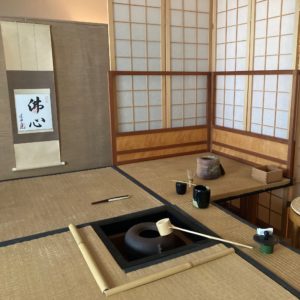
Shiki-shi, 色紙, color-paper, ‘Bu-sshin’, 仏心, Buddha-heart. Kashiwa-de kama, 柏手釜, Oak-hand-kettle. Shiga-raki yaki, 信楽焼, Faith-pleasure fired. Kuro-raku zutsu-ja-wan, 黒樂筒茶碗, black-pleasure cylindrical-tea-bowl. Rikyū-gata chū-natsume, 利休形中棗, Rikyū-style middle-jujube. Naka-bushi cha-shaku, 中節茶杓, middle-node tea-scoop. Ao-dake naka-bushi futa-oki, 青竹中節蓋置, green-bamboo middle-node lid-rest. Masu ken-sui, 枡建水, box measure build-water. The sen-su, 先生, fan-of, marks the place where the sensei would sit.
The ro, 炉, hearth, as pictured above, is Rikyū’s standard of 14 sun kane-jaku. Two lengths of bamboo are placed on the floor to approximate the size of the dai-ro, 大炉, great-hearth, as conceived by Gen-gen-sai, 玄々斎, Mystery-mystery-abstain, XI Iemoto, Urasenke. The size of the dairo is 14 sun kujira-jaku. The kama remains in it relatively standard place, leaving the rest of the ro-dan, 炉壇, hearth-foundation, open to hold a large ceramic tile as a deflector of the fire, shimeshi-bai, 湿し灰, damp-ash, and charcoal for rebuilding the fire. It was a surprise, to me, to learn that the dairo was also 14 sun, when measured with the larger kujira-jaku. The ratio of the standard ro and the dairo is 8 to 10, which is a manifestation of ya-ta, 八咫, eight-span, like the Ya-ta kagami, 八咫鏡, Eight-span mirror, the sacred Shintō symbol of Amaterasu, the sun goddess. Yata is emblematic of ‘infinite vastness’.
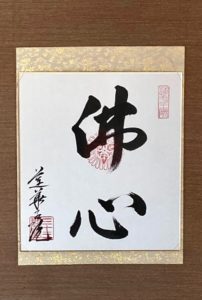
February is the second month of the year, but according to the old kyū-reki, 旧暦, calendar, sometimes called the lunar calendar, the second lunar month begins on February 20 in 2023. Many of the old customs and observances were in accord with the phases of the moon. The Buddha died and entered Ne-han, 涅槃, Black soil-tub, Nirvana, on the full moon of the second month. In 2023, Ne-han-e, 涅槃会, Black soil-tub-meeting, is observed on February 15, as well as on March 6, with the full moon of the second lunar month.
The old name for the second lunar month, which is used for February, is Kisaragi, 如月, meaning ‘likeness month’. This needs some clarification as well. Many events of the lunar calendar have their origins in Buddhism, and the word jogetsu refers to the death and nirvana of the Buddha, when the Buddha became a nyo-rai, 如来, like-become, the Japanese equivalent of the Sanskrit, Tathagata. Jo-getsu, 如月, and Nyo-rai, 如来, have the same Kanji, 如. The Sanskrit word Nirvana means to be blown-out like the flame of a candle, extinguished. The Japanese word for Nirvana is ne-han, 涅槃, black soil-tub. The meaning of 涅 includes simply the word black, stemming from ‘black’ mud. It is composed of Kanji for water, earth, and sun, which implies transformation, earth to clay to sun-dried ceramic.
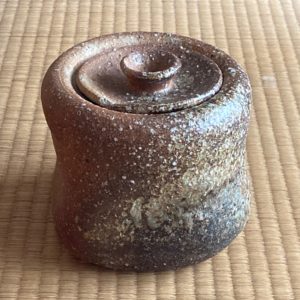
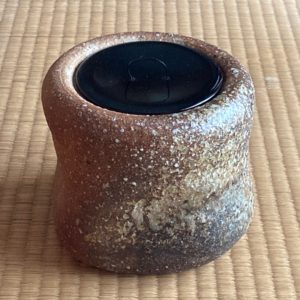
Mizu-sashi, 水指, water-indicate, free-form cylinder with rounded shoulder and bottom, and hai-gusuri, 灰釉, ash-glaze, Shiga-raki yaki, 信楽焼, Faith-pleasure fired; H. 4.4 sun kane-jaku. Left: mizusashi with tomo-buta, 共蓋, self-lid – right: mizusashi with nuri-buta, 塗蓋, lacquered-lid. The two different lids show the change perceived in the appearance of the mizusashi. The self-lid presents a unified appearance, and somewhat timeworn quality, while the black, mirror-finish lacquered lid adds a contrast of refinement, which combined with the earthiness of the mizusashi, could be seen as wabi, 侘び, refined-rusticity.
The subject of wabi has been a concern for those who try to translate the word. Some words require a deep understanding to approximate a translation. ‘Art’ for example. Gengensai developed the concept of ki-rei wabi, 綺麗侘び, beautiful-lovely refined-rusticity. A freshly-picked flower in an ancient Japanese bronze vase is such an example. Wabi must have two elements that have contrasting qualities.
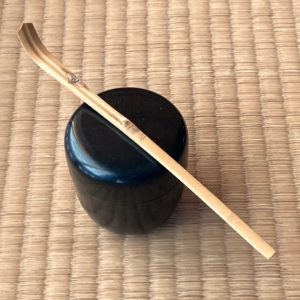
Bamboo that has an insect-eaten hole is quite rare, which is something that is appreciated by cha-jin, 茶人, tea-person. Rikyū-gata chū-natsume, 利休形中棗, Rikyū-style middle-jujube, shin-nuri, 真塗, true-lacquered (black); H. 1.8 sun kujira-jaku.
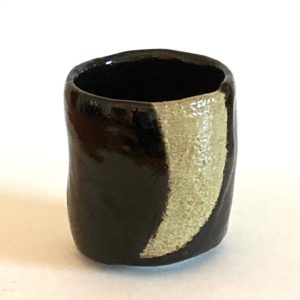
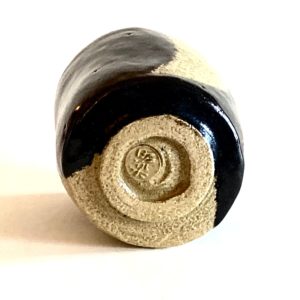
Tsutsu-cha-wan, 筒茶碗, cylindrical tea-bowl, ceramic bowl with very shallow foot, with black glaze with a crescent moon and area unglazed, by Sa-sa-ki Shō-raku, 佐々木昭楽, Assist-assist-tree Bright-pleasure, Kyō; h. 3.4 sun kane-jaku. Cylindrical chawan are used in the cold weather to warm the hands.
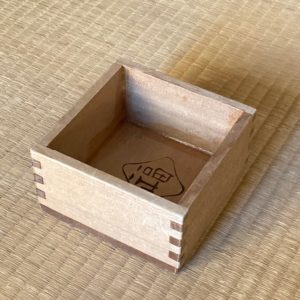
The masu was packaging for go-shiki–mame, 五色豆, five-color beans, sugar-coated dai-zu, 大豆, big-beans, soybeans, red, yellow, green, white, brown, made by Yanagi-ya, 柳屋, Willow-house. A classic great for Setsu-bun, 節分, Spring-divide, which are rather quickly eaten up, leaving a useful masu. Although I have never seen a masu used as a kensui, Setsubun is one of my favorite things, and I thought that the mame-masu would be an appropriate addition.
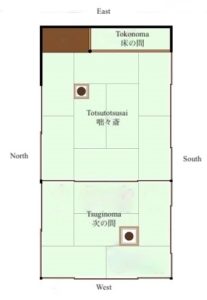
The hachijō and rokujō rooms are separated by removeable fusuma, 襖, sliding wall panels. At Urasenke, Gengensai’s rokujō tsuginoma has fusuma on all sides, including partial shō-ji, 障子, hinder-of, on the south. Because of the fusuma access, the cha-dō-guchi, 茶道口, Tea-way-opening, may be almost anywhere that is convenient.
As there is no tokonoma in the roku-jō, 六畳, six-tatami, a two-fold panel byō-bu, 屏風, hinder-wind, is placed in the southeast corner of the room, and a kake-mono is hung on south panel. The guests sit along the east wall facing west, the Pure Land paradise of A-mi-da, 阿弥陀, Praise-increase-steep, the Buddha of Compassion.
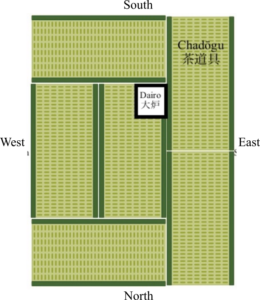
In the Totsutotsusai tsuginoma, the guests sit along the east wall that is opposite the ro, so that the guests face west, the location of Amida’s paradise, Jō-do, 浄土, Pure-land. The principle room of Urasenke’s Konnichian is named Totsu-totsu-sai, 咄々斎, Tsk-tsk-abstain, which is taken from Sōtan’s Buddhist name. The term totsu-totsu, is a kind of reprimand from one’s teacher, hence, tsk-tsk. Totsu-totsu is more ‘sound’ than ‘meaning’.
In the idealized realm of Buddhism, the height of a sculptured image of the standing Buddha is jō-roku shaku, 丈六尺, ten feet-six span, which is about sixteen feet. This class of images is identified as Jō-roku-butsu, 丈六仏, six feet-six-buddha. An image of the Buddha seated with legs crossed is ‘half’ the height of the standing Buddha, and is classified as a Han-jō-roku-butsu, 半丈六仏, half-measure-six-buddha, height is shi-shaku, 四尺, four-span.
In Buddhism, one faces east to pray. The tokonoma is ideally located to the north of the Tearoom, as with the Yū-in, 又隠, Again-retire, Teahut created by Sōtan, which has the tokonoma to the north. A kakemono of Hi-no-de, 日の出, Sun-’s-out, and Ne-han, 涅槃, Black soil-tub, hanging in the tokonoma changes the direction, ideologically, to the east. The Buddha and Buddhism are guarded in each of the four directions by the Shi-jin-jū, 四神獣, Four-god-animals, and the Shi-ten-nō, 四天王, Four-heaven-kings. The guardians of the east are the Sei-ryū, 青龍, Azur-dragon, and Ji-koku-ten, 持国天, Hold-country-heaven (deva).
This is the same orientation of the tenmae in Totsu-totsu-sai, 咄々斎, Tsk-tsk-abstain, Gengensai’s 250th tribute to Rikyū. The tsuginoma dairo no ma, where there is no tokonoma, the teishu using the dairo primarily faces south, as well as the imae which is directed toward the location of the sensei.
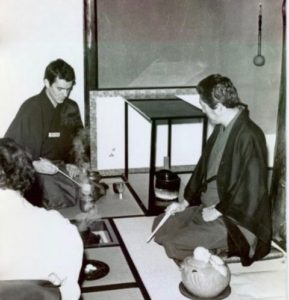
Chanoyu lessons are taught in a room that is collectively called a kei-ko-ba, 稽古場, think-old-place. A teacher is called a sen-sei, 先生, fore-life. In most Tearooms, the sensei sits near or in front of the toko-bashira, 床柱, floor-post. In the standard yo-jō-han, 四畳半, four-mat-half, the tokonoma is identified with the north, which is protected by various deities, of which Sen-ju Kan-non Bo-satsu, 千手観世音菩薩, Thousand-hand See-sound-grass-buddha. The Buddha believed that he was the incarnation of Kannon.
The Buddha faced east during his meditation which lead to his enlightenment, Jō-dō, 成道, Find-way. The Buddha sat on some grasses (tatami origins) beneath a protective tree which became known as the Bodhi Tree, called Bo-dai-ju, 菩提樹, Grass-carry-tree, sacred fig, Ficus religiosa; bodhi tree; bo tree; peepal tree; pipal. Buddha’s tree of enlightenment is also identified as a kind of linden tree that is also called Bodaiju.
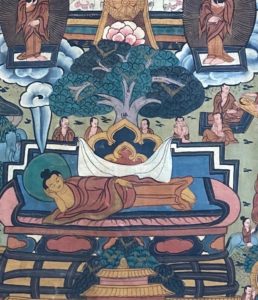
The Bodhi Tree, ‘Awaken Tree’, also called the Mahabodhi Tree, Bo Tree, is a large sacred fig tree, Ficus religiosa, located in Bodh Gaya, Bihar, India. Siddhartha Gautama, the spiritual teacher who became known as the Buddha, is said to have attained enlightenment or Buddhahood circa 500 BCE under this tree. In religious iconography, the Bodhi Tree is recognizable by its heart-shaped leaves, which are usually prominently displayed.
The presence of the sensei identifies the location of the Buddha when he became enlightened. During the cold half of the year when the ro is used to present Tea, the teishu turns toward the tokonoma. This is the general direction of the shō-kyaku, tokonoma, and perhaps most significantly, almost directly the sensei. This is also true in rooms where the ro is in a gyaku-gatte position.
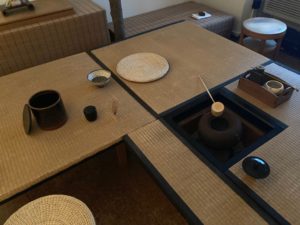
In the above photograph, the arrangement of utensils is purely hypothetical. The circular mat placed on the tatami represents the seat of shō-kyaku, 正客, main-guest, as though turned to prepare Tea using the gray bowl. This arrangement is similar to the location of the teishu in gyaku-gatte. The circular mat on the stool is the location of the teishu in hon-gatte, and when in a gyaku-gatte situation, represents the location of the sensei.
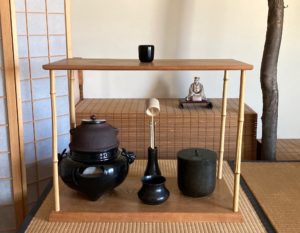

Left: the dai-su, 台子, support-of, with furo and kai-gu, 皆具, all-tools, from the vantage of the host, tei-shu, 亭主, house-master, identified as hon-ga-tte. Right: the daisu with furo and kaigu from the vantage of deity located in the north, which is identified as gyaku-gatte. The image on the right is very like the original arrangement of utensils with the furo on the right. This arrangement of utensils is the same as when Tea is prepared in a room that is gyaku-gatte, however, Urasenke does not usually present more formal tenmae, such as with daisu, in a gyaku-gatte room.

